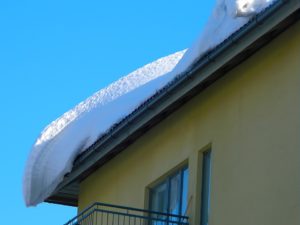
Heavy snow on a roof creates a safety hazard.
While a snow flurry won’t cause much harm, a buildup of heavy, wet snow can wreak havoc on your home, and most homeowners don’t realize the destruction that a winter snowstorm can cause until it’s too late. From basement flooding to fallen trees, a buildup of snow and ice can damage your home and create safety hazards for your family and passers-by. While snowstorms aren’t much of a concern where I live, for those of you who do tend to get a lot of snow, a little preparation can go a long way toward protecting your home from winter storms.
Check Your Roof for Ice Dams and Heavily Packed Snow
Your roof is one of the most vulnerable areas of your home. During winter storms, snow and ice can accumulate, putting excessive weight on your roof and gutters. Ice dams, often caused by poor roof or attic ventilation, can also cause serious damage to your roof and prevent snow from sliding off. Take the time to remove any snow buildup or ice dams from your roof. If necessary, call in a professional to remove the snow and assess your roof for possible damage before the next storm hits.
Protect Outdoor Plants
Not all plants are frost-resistant. If you have container plants outdoors, consider bringing them indoors until the weather warms up. If you have larger plants that cannot be brought indoors, cover them to deter frost damage. You can cover plants with fabric, burlap, old bed sheets, or commercial frost cloth. Avoid using plastic, which can hold moisture against delicate plant tissues, damaging them.
Keep Driveways and Walkways Free of Snow and Ice
Snow and ice on driveways and walkways can be hazardous for those who need to walk on them. As ice and snow builds up during a snowstorm, these surfaces become even more slippery. Keep your driveways and walkways shoveled of loose snow to create a safe walking area. If ice remains, consider sprinkling a chemical deicer over the pathways to encourage melting. You can also find natural deicers in most home improvement stores. To add traction on slippery surfaces, put down materials like kitty litter, sand, straw, or wood chips.
Stock an Emergency Kit
You never know when an emergency is going to happen. If you know that a snowstorm is coming, prepare by stocking up your emergency kit. In this kit, include essentials like food, water, and first aid supplies. You may also want to have other items on hand such as a battery-operated radio, candles and matches, a flashlight and extra batteries, and even a shovel in the unlikely event that you get snowed in.
Prevent Your Water Pipes From Freezing and Bursting
With heavy snow often comes bitterly cold temperatures. In cold temperatures, pipes in your home have the potential to freeze. Studies have found that uninsulated pipes can freeze at just 20 degrees Fahrenheit. To minimize the risk of your pipes freezing and potentially bursting, keep the cabinet doors under your sinks open to allow warm air to reach them. If possible, insulate the water pipes in your home with foam pipe insulation before the storm arrives.
